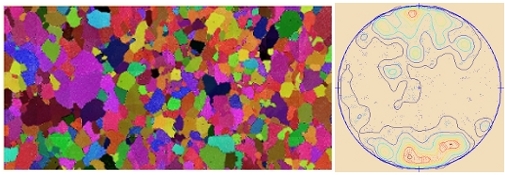Ice crystal measurements

The Each coloured field is an ice crystal and the colours represent the ice crystal orientations.
The colourful image to the left shows a 300 micrometer thick ice sample from 440 m depth in the NEEM ice core that was obtained yesterday. The sample is about 9 cm wide and 4 cm high and the top of the sample (upwards) points to the left. The sample is held between crossed linear polarizers whereby individual ice crystals can be identified. Each coloured field is an ice crystal and the colours represent the ice crystal orientations. At this depth the crystal orientations are almost random which is reflected in great colour variety of the image. Ice crystals in ice sheets live their own life: they grow, they rotate, they break apart and they deform. The warmer the ice, the more dynamic the crystals. As crystals sink deeper into the ice sheet they will tend to have a preferred orientation. In a similar image of ice crystals obtained from a greater depth the ice crystals would thus be more uniformly coloured. The figure to the right is a representation of the crystal orientations showing that already at 440 m depth the crystals have a slightly preferred orientation indicated by the red areas in the vertical direction. The individual ice crystals have a layered structure and the ice flow is strongly influenced by the ice crystal orientations. Advanced ice flow models that are used to predict the future state of the Greenland ice sheet take into account the ice crystal orientations and, therefore, detailed ice crystal measurement are carried out all along the ice core.
What we have done today:
- Drilling with the NEEM long drill: 25.82 m. Drillers depth: 762.00 m.
- Ice core processing: 24.75 m. Depth: 484.55 m.
- CFA analysis: 17.05 m. Depth: 165.00 m.
- Continuing BAS radar profile west of camp
- Changing oil on main generator.
- Sampling pit for 10Be for Anna Storm.
- Testing how rain gutters can be used to cover brittle ice cores so they
break less apart.
Ad.1:
Today the drill needed some maintenance so drilling was interrupted for
several hours.
Drillers report June 29:
"Coring continues to go well in the drilling
trench and we drilled 33.78 metres. The finish depth for the day was
736.18 m."
Weather: Mostly clear sky, broken evening clouds, ground fog at night, temperatures from -8 to -16 deg C, winds 3-12 knt from SW.
Field Leader, Anders Svensson
| ← Previous entry | Next entry → |

